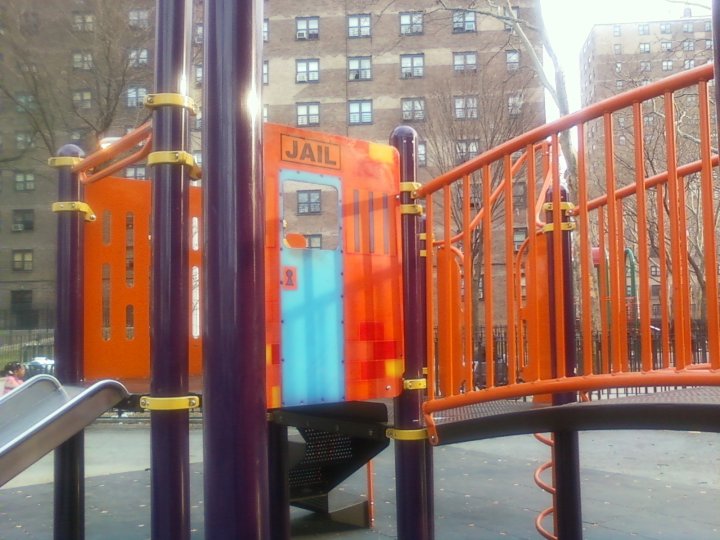Tykes Encouraged to Play in a Makeshift Jail
March 26, 2010 • By Tiffani Knowles
 Community members in the Bedford-Stuyvesant neighborhood of Brooklyn who took notice of a 'play jail' situated on a New York City Housing Authority property claim it to be an underhanded method of exposing at-risk youth to jail at a very early age.
Community members in the Bedford-Stuyvesant neighborhood of Brooklyn who took notice of a 'play jail' situated on a New York City Housing Authority property claim it to be an underhanded method of exposing at-risk youth to jail at a very early age.A makeshift celldoor with the word "jail" printed above it is a part of a jungle gym structure located at Tompkins Houses, where Black and Latino children live and play.
On March 21, BlackandBrownNews.com published a photograph of the play jail, which was shot and submitted by Brooklyn resident Monifa Bandele.
The news source contacted the press office of New York City Mayor Michael Bloomberg stating, "whether or not the word "jail" was painted on or after the city erected the apparatus or it came manufactured with "jail" written on it, this egregious offense still falls on the city to take corrective action immediately."
 BlackandBrownNews.com wrote, asking the City of New York to respond with the same urgency and expediency it would for residents - including children - who live and play in city owned-operated parks on the Upper West Side, a much more affluent neighborhood in New York City.
BlackandBrownNews.com wrote, asking the City of New York to respond with the same urgency and expediency it would for residents - including children - who live and play in city owned-operated parks on the Upper West Side, a much more affluent neighborhood in New York City. However, this issue may never arise in an area like the Upper West Side, which boasts some of the city's best parks, according to Time Out New York.
BlackandBrownNews.com has requested that the play jail in Tompkins Houses be disassembled and replaced with a "suitable, appropriate and safe recreational apparatus within 24 hours."
They have yet to hear responses from the Mayor’s Office or the New York City Housing Authority.
This discovery is set in an era where Blacks and Latinos in America enter the criminal justice system at a disproportionate rate.
 For the Black community, nearly one-fourth of its young men are under the control of the criminal justice system at a time when their peers of other races are beginning families, learning constructive life skills, and starting careers.
For the Black community, nearly one-fourth of its young men are under the control of the criminal justice system at a time when their peers of other races are beginning families, learning constructive life skills, and starting careers. Latino convicts now represent the largest ethnic population in the federal prison system, accounting for 40 percent of those convicted of federal crimes. Nearly half of Latino offenders, or about 48 percent, were convicted of immigration crimes, while drug offenses were the second-most-prevalent charge, according to a report by The Pew Research Center.
"The consequences of this situation for family and community stability will be increasingly debilitating," said Marc Mauer, Executive Director of The Sentencing Project, a national organization working for a fair and effective criminal justice system by promoting reforms in sentencing law and practice, and alternatives to incarceration. "Unless the criminal justice system can be used to assist more young Black males in pursuing these objectives, any potential positive contributions they can make to the community will be delayed, or lost forever."
 Mauer points out in his essay, "Young Black Men and the Criminal Justice System: A Growing National Problem," that the law enforcement approach to drugs in the U.S. creates an inherent social problem.
Mauer points out in his essay, "Young Black Men and the Criminal Justice System: A Growing National Problem," that the law enforcement approach to drugs in the U.S. creates an inherent social problem.The approach results in even higher rates of incarceration for Blacks and Hispanics since drug law enforcement is largely targeted against "crack," more often used by low-income Blacks and Hispanics.
As drug offenders make up an increasing share of the prison population, the non-white prison population will become disproportionately larger.
In Florida, for example, Blacks inmates now make up 73.3 percent of all drug offenders, compared to 53.6 percent of prison admissions for other offenses.
In New York, where this play jail can be found, minorities account for 87.6% of the growth in New York's prison population since 1970. Within the shorter period of 1985 - 1997, the figure was 90%, higher than any other state. Whites make up 16% of New York prisons, Blacks 51% and Latinos 31%.
 Peter Wagner, Executive Director of the Prison Policy Initiative states that "since 1930, the odds of being sent to prison in New York State for a white person in a given year has actually fallen slightly, but the odds of a Black person being sent to prison in a given year has risen more than 250%."
Peter Wagner, Executive Director of the Prison Policy Initiative states that "since 1930, the odds of being sent to prison in New York State for a white person in a given year has actually fallen slightly, but the odds of a Black person being sent to prison in a given year has risen more than 250%." And, in Texas, the South Central Texas Narcotics Task Force was sued for conducting racially motivated drug sweeps in Hearne, Tx. for more than 15 years. The motion picture, American Violet, was based on the story of one of the wrongly convicted, Dee Roberts.
Mauer believes that measures must be taken to reduce the likelihood of offenders returning to the system, such as "diverting as many youthful, minor and firsttime offenders as possible from the criminal justice system entirely."
"Encouraging young Black and Latino children to first play in jail until they may actually get to jail or prison is playing loosey-goosey with their young, impressionable psyche and something no community should stand for or be subjected to," said BlackandBrownNews.com
Related Articles · More Articles
The public charge rule that rendered immigrants inadmissible or ineligible for green cards if they accept government assistance was overturned in September and new rule, allowing immigrants to receive food stamps, healthcare services and other government aid, took effect December 23, 2022.
This Christmas, R&B singer-writer-producer Ne-Yo, stars in the BET+ original holiday remake of “The Sound of Music" directed by Booker Mattison.
Trump is like an aging boxer well past his prime, who does not know when to quit. Yet, which political stands in the wings? I think we all know.

